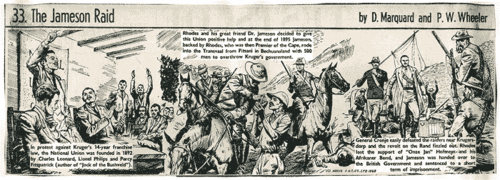By 1895 Britain was getting more confident about taking action in South Africa. Joseph Chamberlain was appointed Colonial Secretary. He joined forces with Rhodes to try to develop and promote the British Empire in South Africa.
In September and October 1895 the Drift Crisis between the Cape Colony and the Transvaal or SAR developed. The Cape had finished building a railway line to Johannesburg and tried to get as much of the Transvaal's railway traffic as it could by reducing its rates. It was aware that the Transvaal's Delagoa Bay line was al most complete. The Transvaal government increased the rates on the part of the railway that ran through the Transvaal once it had crossed the Vaal River. In answer to this, goods were taken to the Vaal River by train, and then taken further by wagon to avoid paying the higher prices in the Transvaal. Kruger reacted by blocking access to the Transvaal, closing the drifts on the Transvaal side. The British government demanded that Kruger open the drifts and used the situation to involve itself directly in Transvaal affairs.
In addition to the Drift crisis the Jameson Raid was the culmination of the activities of the Reform Movement, which a number of successful mining and business personalities started in the turbulent early days of Johannesburg, with the support of Cecil John Rhodes. British and Jewish Businessmen protested against what they felt to be the Boer Transvaal Government's discriminatory attitude to the Uitlanders (foreigners) in Johannesburg, who had contributed in no small measure to the growth of the mining town. The Kruger government had been putting pressure on the mining companies in the form of taxes, and they maintained monopolies over items such as the dynamite needed for deep-level blasting and for railway construction which led to high transport tariffs. As no attempt was made to solve the Uitlanders' grievances by peaceful discussion and negotiations, Rhodes began planning an uprising of Uitlanders in Johannesburg, and the Reform Movement decided to overthrow the government by taking up arms. The uprising was timed to coincide with an invasion of the Transvaal from Bechuanaland (present day Botswana), by Dr Leander Starr Jameson. Rhodes wanted to take over the government of the Transvaal and turn it into a British colony that would join all the other colonies in a federation. Chamberlain helped plan the Jameson Raid.
The Raid
 The Jameson Raid, illustration by P. W. Wheeler, taken from South African History in Pictures, as published in The Star. Hold mouse pointer over text blocks in the image to see transcription...
The Jameson Raid, illustration by P. W. Wheeler, taken from South African History in Pictures, as published in The Star. Hold mouse pointer over text blocks in the image to see transcription...
The raid was launched on 29 December 1895, when Jameson and armed forces crossed the border from Bechuanaland (Botswana). Jameson, however, had been too hasty. Earlier, while Jameson waited on the border, the Uitlander leaders in Johannesburg were arguing among themselves about the kind of government to be put into place after the invasion. Many of the Uitlanders had no interest in violent uprising. Rhodes had actually decided to call off the raid, but by that time it was too late as Jameson and his party had already crossed into the Transvaal.
Communication was lacking and plans were botched when all telegraph lines were not cut as had been planned. Consequently, the Boers received warning of the attack, and Jameson was forced to surrender on 2 January 1896 at Doornkop near Krugersdorp. The raid had been a failure.
The prisoners were handed over to their own government and the Uitlander leaders who had been part of the plot were put to trial in Johannesburg. Some of them were condemned to death, but the sentences were later reduced to large fines.
Rhodes was forced to resign as the premier of the Cape Colony and the political problems between Afrikaans and English-speaking people became worse than ever in the colony. The Orange Free State co-operated more closely with the Transvaal. Transvaal residents felt that they were being threatened and Uitlanders were treated with more suspicion than ever before.
